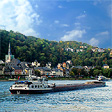BRIDGE AT REMAGEN
Last Bridge on the Rhine of WWII and Peace Museum
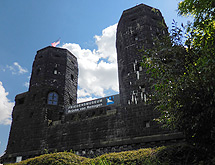 It’s real name was the Ludendorff Bridge, but is now forever known by its location, as the Bridge at Remagen, made famous by a book and a 1960s movie of its story, the bridge across the Rhine River which understood days of assault by German and allied forces, remaining standing to be captured by the allies, only to crash into the river from its own weight and damage from the brutal fight. Today, the blackened stone towers of the bridge support foundations stand like the ruins of some mysterious castle on either side of the Rhine River south of Bonn, at the edge of the town of Remagen, a reminder of war’s struggle and human folly.
It’s real name was the Ludendorff Bridge, but is now forever known by its location, as the Bridge at Remagen, made famous by a book and a 1960s movie of its story, the bridge across the Rhine River which understood days of assault by German and allied forces, remaining standing to be captured by the allies, only to crash into the river from its own weight and damage from the brutal fight. Today, the blackened stone towers of the bridge support foundations stand like the ruins of some mysterious castle on either side of the Rhine River south of Bonn, at the edge of the town of Remagen, a reminder of war’s struggle and human folly.
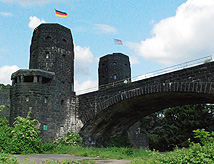 The Bridge at Remagen not only has a place in the history of World War II, but also has a place in the story of the First World War. The longest single span railway bridge across the Rhine River, the bridge was first proposed in 1912, and built during 1916 to 1918 to carry trips and supplies across the Rhineland to the Western Front. At its dedication Kaiser Wilhelm II named it in honor of then Army Quartermaster General Erich Ludendorff, the victor of the Battle of Liege in 1916 (see Fort Batice Herve), and later a rival of Von Hindenburg and proponent of rebuilding of the German war machine, the author of the theory of “Total War”.
The Bridge at Remagen not only has a place in the history of World War II, but also has a place in the story of the First World War. The longest single span railway bridge across the Rhine River, the bridge was first proposed in 1912, and built during 1916 to 1918 to carry trips and supplies across the Rhineland to the Western Front. At its dedication Kaiser Wilhelm II named it in honor of then Army Quartermaster General Erich Ludendorff, the victor of the Battle of Liege in 1916 (see Fort Batice Herve), and later a rival of Von Hindenburg and proponent of rebuilding of the German war machine, the author of the theory of “Total War”.
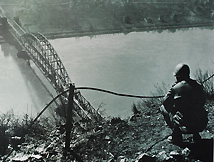 Taking longer to build than planned due to the strains of rising war costs for the Kaiser, the railroad tracks across the bridge never managed to carry many troops to the front, and was used mostly by the retreating German Army in November of 1918 and by the advancing American occupation troops. It was only fully completed after the war in 1919, and then almost unused over in the next two decades until the German advance of 1940.
Taking longer to build than planned due to the strains of rising war costs for the Kaiser, the railroad tracks across the bridge never managed to carry many troops to the front, and was used mostly by the retreating German Army in November of 1918 and by the advancing American occupation troops. It was only fully completed after the war in 1919, and then almost unused over in the next two decades until the German advance of 1940.
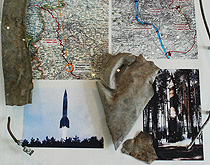 Through much of the war the Remagen bridge “Watch on the Rhine” as the guards were called, was mostly mundane and quiet, and the high command didn’t think it very important, until the Normandy landings. During 1944 in the advance of the allies across Belgium (see Battle of The Bulge WWII Sites) and in early 1945, as a major railway junction, the bridge was a target of multiple allied air attacks, suffering damage, but never falling.
Through much of the war the Remagen bridge “Watch on the Rhine” as the guards were called, was mostly mundane and quiet, and the high command didn’t think it very important, until the Normandy landings. During 1944 in the advance of the allies across Belgium (see Battle of The Bulge WWII Sites) and in early 1945, as a major railway junction, the bridge was a target of multiple allied air attacks, suffering damage, but never falling.
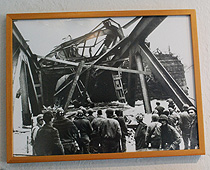 On March 7, 1945 soldiers of the US Army 9th Armored Division captured the bridge almost completely unexpectedly. A German demolition team has attempted to blow up the bridge in face of the allied advance, but the demolition failed and the bridge was undefended. General Eisenhower is reported to have called this prize the “Miracle at Remagen”, suggesting the bridge was worth its “weight in gold”. But it was weight which did what German demolition frogmen, dive bombers, and even a V2 rocket fired at it by the Germans couldn’t. Ten days after being captured, steel of the bridge suddenly buckled and collapsed, carrying 30 American soldiers with it to their deaths in the river. Adolf Hitler suspected treason and had five officers sentenced to death for losing the bridge and four of them shot immediately. He bit the bullet himself not too long after.
On March 7, 1945 soldiers of the US Army 9th Armored Division captured the bridge almost completely unexpectedly. A German demolition team has attempted to blow up the bridge in face of the allied advance, but the demolition failed and the bridge was undefended. General Eisenhower is reported to have called this prize the “Miracle at Remagen”, suggesting the bridge was worth its “weight in gold”. But it was weight which did what German demolition frogmen, dive bombers, and even a V2 rocket fired at it by the Germans couldn’t. Ten days after being captured, steel of the bridge suddenly buckled and collapsed, carrying 30 American soldiers with it to their deaths in the river. Adolf Hitler suspected treason and had five officers sentenced to death for losing the bridge and four of them shot immediately. He bit the bullet himself not too long after.
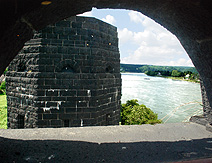 Today, the towers of the former bridge still stand on either bank of the river. The steel structure is all gone with some remaining sections of the approach stone bride structure on the western side, when inside the stone towers of the western bank is the Peace Museum (Friedens Museum) dedicated to the story of the bridge and a memorial to peace. The museum and memorial was the idea of Remagen City mayor Hans Peter Kürten. He had the idea to sell little pieces of the bridge with authenticity certificates to finance the project and the museum opened in 1980. The museum has various documents and photographs about the bridge and its capture as well as an exhibition about a prisoner-of-war camp set up by the Americans for captured Germans between April and July of 1945. Two sections of the museum in either tower are reached through the upper crossing bridge between the towers with views through the defensive observation windows.
Today, the towers of the former bridge still stand on either bank of the river. The steel structure is all gone with some remaining sections of the approach stone bride structure on the western side, when inside the stone towers of the western bank is the Peace Museum (Friedens Museum) dedicated to the story of the bridge and a memorial to peace. The museum and memorial was the idea of Remagen City mayor Hans Peter Kürten. He had the idea to sell little pieces of the bridge with authenticity certificates to finance the project and the museum opened in 1980. The museum has various documents and photographs about the bridge and its capture as well as an exhibition about a prisoner-of-war camp set up by the Americans for captured Germans between April and July of 1945. Two sections of the museum in either tower are reached through the upper crossing bridge between the towers with views through the defensive observation windows.
Visiting the Bridge at Remagen
The Peace Museum is open daily from 10 am to 6 pm from May through October and 10 am to 5 pm November to March. Admission price is €3.50 for adults, €1 for juveniles, students and disabled, with a €7 family ticket. To get to the bridge follow the signs to the “Friedensmuseum”. Remagen itself is a summer tourist town on the banks of the river with a riverside walk, Roman Museum and medieval old town section. © Bargain
Travel Europe
Find best travel deals on the Rhine River on TripAdvisor
Web Info
Remagen Freidensmuseum
These articles are copyrighted and the sole property of Bargain Travel Europe and WLPV, LLC. and may not be copied or reprinted without permission.
See Also:
RHINE RIVER CRUISE KD LINE
SCHLEISSHEIM FLIGHT WORKS MUSEUM
COLDITZ CASTLE WWII POW ESCAPES

